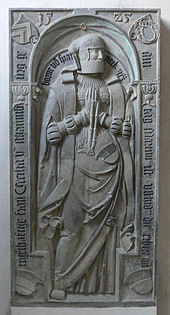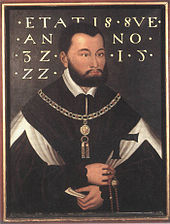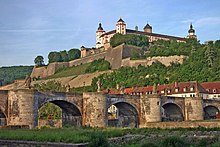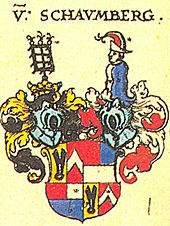New Year's Eve from Schaumberg
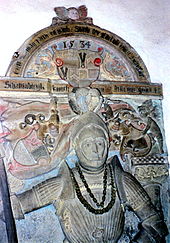
Silvester von Schaumberg , also Sylvester Knoch (* between 1466 and 1471; † June 29, 1534 ) was imperial knight and bailiff of Münnerstadt , Veldenstein and Parkstein . He was an early supporter of Martin Luther .
Origin and upbringing
New Year's Eve came from the von Schaumberg family . The Ehnesian line to which he belonged was nicknamed Knoch. His father was Simon von Schaumberg, his mother Kunigunde Gotzmann von Thurn. He had at least seven siblings. Earlier genealogists, such as Salver or Johann Gottfried Biedermann , classify New Year's Eve completely incorrectly. Based on the later sources, his birth can be determined between 1466 and 1471. Silvester did not receive a comprehensive education. He wrote his papers in simple German, not like e.g. B. the educated contemporary Sebastian von Rotenhan in Latin. Nevertheless, he showed a high level of interest and commitment in relation to the religious questions of this time. He was not familiar with humanistic ideas. His decisions were shaped by a legal awareness that clearly differs from today's ideas with feuding , and he distinguished himself from robber baronism .
Ganerbeburg Rothenberg
He was considered worthy to buy into the community of inheritors of Rothenberg Castle with a share of the property . Due to the alliance system of the many residents and their families in the area as well as the border situation of various territorial states, this offered extensive autonomy for the local knighthood. At the end of the 15th century there were 44 parties in the castle that stood by in dangerous situations, later the number continued to increase.
In the time of the Bamberg bishops Heinrich III. Groß von Trockau and Veit I. Truchseß von Pommersfelden , he led several feuds against the bishopric of Bamberg . Silvester remained true to the correct procedure of a feud since they were justified by the implementation of justified claims and before the other side have been announced, but he violated the commandment of the public peace , and so he came first in 1493 in the night . Such feuds consisted of incursions by troops of horsemen into opposing villages, which were looted and whose inhabitants were taken hostage or killed as subjects of the bishop. This affected the village of Welitsch in 1493 , and Konrad Schott von Schottenstein was one of the signatories of the feud in question . In 1501 the village of Leutenbach was a destination. The episcopal troops reacted and devastated the village of Schnaittach in 1502 . In the period that followed, both sides tried to negotiate and relations relaxed.
Princely services
With the death of his father, Silvester inherited property in Münnerstadt, where his mother remained as a widow and there he went into the service of the Henneberg family . In the Landshut War of Succession he sided with Ruprecht von der Pfalz . The Franconian knighthood fought on both sides in this war. The combat-experienced Wilwolt von Schaumberg was also on Ruprecht's side. Like other well-known supporters of Ruprecht, New Year's Eve was ostracized at the beginning of the war ; this was lifted again at the end of the conflict.
Silvester married Cecilia († November 11, 1525), born von Sparneck . She came from the Weißdorfer line of the family and was a daughter of Christoph von Sparneck and Elisabeth, a née Seckendorf-Rinhofen . Eight children survived their parents. Ambros († before 1536) took part in the Turkish campaign as an elder with his father. Karl († 1578) was a bailiff in Wildberg. Wolf Dietrich († 1536) was a Bamberg and Würzburg canon , he was stabbed to death.
The legacy of Silvester's father was insufficient for a befitting life, and the income from his scattered possessions was partly made up of very small amounts. For this reason, he went into princely services, initially as a Hennberg bailiff in Münnerstadt, as a bailiff of Pfalz-Neuburg at Parkstein Castle and as a Bamberg bailiff of Veldenstein . With Veldenstein he was responsible for a border region that was in the immediate vicinity of Rothenburg. He was still associated with this as one of many owners and thus still a guarantor in the event of a threat. On the other hand, it is also clear that the phase of feuds against Bamberg possessions was considered to be over and there were no after-effects, which corresponded to the understanding of feuds at the time. In addition, his paternal inheritance was also in the Bamberg area. He only held the respective offices for a few years, which corresponded to the handling of the time.
In Münnerstadt he continued his previous creative period and gained in importance over several years in his function as bailiff. He enjoyed the trust of the Hennebergers, especially his employer Wilhelm von Henneberg. He was involved in negotiating the truce with Würzburg , half of which was owned by Münnerstadt, and took part in contract negotiations with Saxony regarding disputed areas. His office apparently also allowed him the freedom to pursue personal interests extensively and to move away from the city at times. Only during his longer absence in 1518 was Jörg von Bibra temporarily appointed as bailiff. Silvester had joined the last Grand Master of the Teutonic Order Albrecht , whose campaign led him to the unsuccessful siege of Danzig . He then took part in the efforts of the Danish King Christian II , who had been expelled from his country in 1523 and was striving back to the throne with the help of his allies. The collected troops of Albrecht lost their way in Coburg and Erfurt due to a lack of funds and New Year's Eve, who claimed the provision of 30 horses, was compensated by Albrecht's brother, Margrave Casimir in 1527, who was apparently interested in a good relationship with New Year's Eve.
Movement of the knighthood
New Year's Eve was also committed to his own estate. The decline of the knightly estate had many reasons and in the end it was unstoppable. In 1515, New Year's Eve had gone out with nine horsemen when the murder of Hans von Hutten sparked outrage in circles of the knighthood, but the combat-ready group broke up again before clashes broke out. The failure of the Knight's War , combined with the death of Franz von Sickingen and the punitive expedition of the Swabian Federation in the Franconian War , destroyed many knights' ideas of giving their class a new meaning around 1523.
The knights tried to gain unity through the organization in knightly cantons and to build political influence over the territorial states. In this context, Silvester was one of the councilors of Moritz Marschall von Ostheim , the captain of the canton of Rhön-Werra . Another development was the unions in which knights positioned themselves on moral issues. Religious topics also had their place there. In January 1523, more than 400 Franconian aristocrats came together in Schweinfurt as the unity, but the differences of opinion were too great to agree on joint action.
Large parts of the Franconian knighthood had sympathy for Martin Luther's criticism at a very early stage and saw in him a bearer of hope. For some, there was only a secondary connection with political conclusions. Like the famous knights Ulrich von Hutten and Franz von Sickingen , Silvester was a friend and supporter of Martin Luther. He let his eldest son Ambrosius study at the University of Wittenberg . In a letter to Luther, he expressed his concern for his safety in Wittenberg and offered him protection in the Franconian area . For the region around Münnerstadt and the Schaumberg lordship of Thundorf , which Silvester administered for his relatives and is accepted there as the founder of a knight school, he promoted the idea of the Reformation as far as his position towards his employer allowed. In the dioceses of Würzburg and Bamberg , the church princes were initially very open with the new ideas, Lorenz von Bibra and Georg III. Schenk von Limpurg allowed many innovations, only under their successors did the contrasts intensify. Some princes, such as B. Margrave Casimir , took advantage of the situation and, with the dissolution of monasteries, pursued a strengthening of their own position within their sphere of influence.
Peasants' War
Due to acquisitions in Münnerstadt and his activity as a Henneberg bailiff, Silvester ended up in the service of the Würzburg bishopric . There are other indications that Silvester's turn to the Reformation did not mean a complete break with the existing political and religious structures. When the Peasants' War broke out , he immediately followed the bishop's call for assistance. He was part of a delegation that the bishop sent to negotiate with the farmers arriving from the direction of Tauberfranken . The delegation consisted of the Würzburg court master Sebastian von Rotenhan as leader and spokesman, Marshal Heintz Truchseß , Kunz von Rosenberg and two ambassadors from the knighthood, in addition to Silvester this was Count Wolfgang von Castell . The negotiations with the peasant captains were unsuccessful. Further groups of peasants formed in the diocese and joined the uprising. In early April 1525, the Bildhausen monastery in the Münnerstadt area was stormed by Münnerstadt citizens and farmers, the "Bildhäuser Haufen". On April 12, farmers set up a fortified camp there, while another troop took the Münnerstadt monastery and the house of the Teutonic Order . New Year's house was also looted. Cecilia died that same year.
New Year's Eve was deployed with a troop of riders as scouts, who were supposed to observe the approaching " Black Heap " under Florian Geyer . The heap united with the "Hellen Haufen" under Götz von Berlichingen and advanced in the direction of Würzburg . While the city joined the rebels and Bishop Konrad II of Thüngen fled shortly before the peasants arrived, a relatively small delegation was entrusted with the defense of the Marienberg Fortress . New Year's Eve was assigned to the fortress commander, Margrave Friedrich von Brandenburg-Ansbach . Negotiations with the insurgents in which he took part were unsuccessful. The storm of the fortress failed with heavy losses for the peasants. The situation changed decisively when both the bishop advanced with troops and the army of the Swabian League approached. The Peasants' War was completely put down a little later. At the beginning of the 20th century , Paul Hindemith dealt with the events of the uprising in his opera Mathis der Maler , in which the person of New Year's Eve also plays a role, although not always following historical events.
At the end of the Peasants' War, Silvester was part of a commission that the bishop set up to compensate his knightly followers for the destruction of their possessions. In 1526, Silvester was again bailiff of Münnerstadt and also of Burglauer . He held this office until his death.
At an advanced age, New Year's Eve must also have been wealthy, because he was a believer in the Margraves Casimir and Georg , Count Wilhelm von Henneberg and the Bishop of Würzburg. As a bailiff, he pledged various rights and taxes in Münnerstadt, which made him a highly influential person on site. Together with his son Ambros, he participated in the war against the Turks during their siege of Vienna in 1529 . He died in 1534 and reached the old age of over 60.
Epitaphs
The epitaphs of Silvester, his wife Cecilia and their son Karl are in the church of St. Maria Magdalena in Münnerstadt.
The grave of New Year's Eve shows him in knight armor, the so-called Milanese armor , framed by columns and a semicircular roof of the early Renaissance. About him are gemehrte Schaumberger coat of arms and crest Tree Schaumberg, Gotsmann , Stiebar and Waldenfels attached. The figure is very detailed and sculptured. She is armed with a sword and a spear with a colored pennant blowing. The burgundy-shaped helmet wears feather headdresses, the shoes are bear claws . She wears a heavy gold chain around her neck.
As an elegant patrician, Cecilia wears an outer garment and undergarment with a scarf over it . She holds a rosary in her folded hands . Her head is covered by a hood and a rise except for the eyes and nose. In addition to the Schaumberg coat of arms, there are references to their origins by those of von Sparneck, Seckendorff , Vestenberg and the Schenk von Geyern . The tomb is an early work by Bernhard Friedrich.
literature
- Friedrich Kipp : New Year's Eve von Schaumberg, Luther's friend - A picture of life from the time of the Reformation . Leipzig 1911.
Web links
Individual evidence
- ↑ Kipp, p. 14.
- ↑ Alban von Dorbenck : History of the extinct family of the von Sparneck (part 1/2). In: Archives for the history of Upper Franconia. Bayreuth 1905/1906. Reprint: ISBN 978-3-8370-8717-8 . Reprint pp. 61f., 152
- ↑ http://www.von-schaumberg.net/sylvesterbrief.html
- ↑ Archived copy ( Memento of the original from May 14, 2014 in the Internet Archive ) Info: The archive link was inserted automatically and has not yet been checked. Please check the original and archive link according to the instructions and then remove this notice.
- ↑ Karl Dinklage: Fifteen Centuries of Münnerstadt History . Bad Königshofen 1983. pp. 146, 149.
- ↑ Peter Braun: The Lords of Sparneck - family tree, distribution, brief inventory . In: Archives for the history of Upper Franconia . Bayreuth 2002. pp. 90f.
| personal data | |
|---|---|
| SURNAME | New Year's Eve from Schaumberg |
| ALTERNATIVE NAMES | Sylvester von Schaumberg, called Knoch |
| BRIEF DESCRIPTION | Imperial knight and bailiff of Münnerstadt, Veldenstein and Parkstein |
| DATE OF BIRTH | between 1466 and 1471 |
| DATE OF DEATH | June 29, 1534 |
